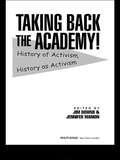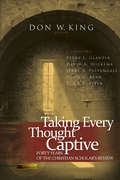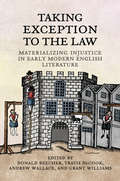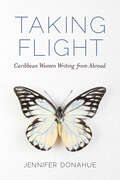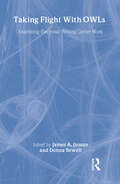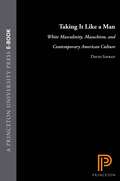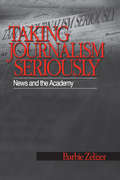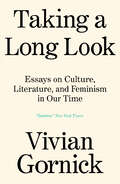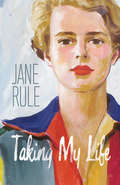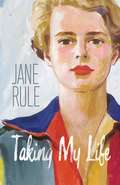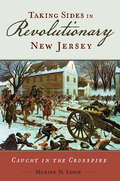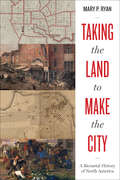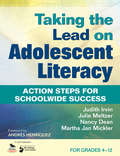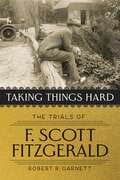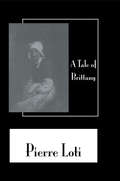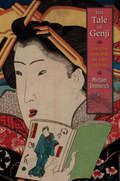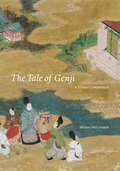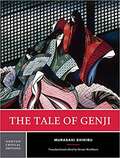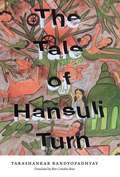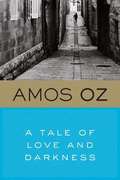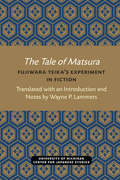- Table View
- List View
Taking Back the Academy!: History of Activism, History as Activism
by Jim Downs Jennifer ManionFirst published in 2004. Routledge is an imprint of Taylor & Francis, an informa company.
Taking Every Thought Captive: Forty Years of the Christian Scholar's Review
by Don W. KingTaking Every Thought Captive celebrates forty years of the Christian Scholar's Review by collecting a representation of the best scholarship to appear in its pages from inception in 1970 through 2010.Over its forty years of publication, CSR has had two main objectives: "the integration of Christian faith and learning on both the intra- and inter-disciplinary levels" and "to provide a forum for the discussion of the theoretical issues of Christian higher education."The twenty-four articles gathered in this anniversary collection reflect both of these objectives. As a whole, this collection witnesses to the rigors of the intellectual enterprise found within the pages of CSR and affirms an ongoing commitment to support, enhance, and promote Christian scholarship.Contributors include: Carl F. H. Henry, Arthur F. Holmes, George Marsden, Mary Stewart Van Leeuwen, Stanley Hauerwas, Richard J. Mouw, Mark A. Noll, Dallas Willard, Elizabeth Newman, Roger Lundin, Nancy Ammerman, Nicholas Wolterstorff, and fifteen others.
Taking Exception to the Law: Materializing Injustice in Early Modern English Literature
by Edited by Donald Beecher Travis Decook Andrew Wallace Grant WilliamsTaking Exception to the Law explores how a range of early modern English writings responded to injustices perpetrated by legal procedures, discourses, and institutions. From canonical poems and plays to crime pamphlets and educational treatises, the essays engage with the relevance and wide appeal of legal questions in order to understand how literature operated in the early modern period. Justice in its many forms – legal, poetic, divine, natural, and customary – is examined through insightful and innovative analyses of a number of texts, including The Merchant of Venice, The Faerie Queene, and Paradise Lost. A major contribution to the growing field of law and literature, this collection offers cultural contexts, interpretive insights, and formal implications for the entire field of English Renaissance culture.
Taking Flight: Caribbean Women Writing from Abroad (Caribbean Studies Series)
by Jennifer DonahueCaribbean women have long utilized the medium of fiction to break the pervasive silence surrounding abuse and exploitation. Contemporary works by such authors as Tiphanie Yanique and Nicole Dennis-Benn illustrate the deep-rooted consequences of trauma based on gender, sexuality, and race, and trace the steps that women take to find safer ground from oppression. Taking Flight examines the immigrant experience in contemporary Caribbean women’s writing and considers the effects of restrictive social mores. In the texts examined in Taking Flight, culturally sanctioned violence impacts the ability of female characters to be at home in their bodies or in the spaces they inhabit. The works draw attention to the historic racialization and sexualization of black women’s bodies and continue the legacy of narrating black women’s long-standing contestation of systems of oppression. Arguing that there is a clear link between trauma, shame, and migration, with trauma serving as a precursor to the protagonists’ emigration, Jennifer Donahue focuses on how female bodies are policed; how moral, racial, and sexual codes are linked; and how the enforcement of social norms can function as a form of trauma. Donahue considers the relationship between trauma, shame, and sexual politics and investigates how shame works as a social regulator that frequently leads to withdrawal or avoidant behaviors in those who violate socially sanctioned mores. Most importantly, Taking Flight positions flight as a powerful counter to disempowerment and considers how flight, whether through dissociation or migration, functions as a form of resistance.
Taking Flight With OWLs: Examining Electronic Writing Center Work
by James A. Inman Donna SewellTaking Flight With OWLs examines computer technology use in writing centers. Its purpose is to move beyond anecdotal evidence for implementing computer technology in writing centers, presenting carefully considered studies that theorize the move to computer technology and examine technology use in practice. Writing centers occupy a dynamic position at the crossroads of computers and composition, distance education, and composition theory, pulling ideas, theories, and pedagogies from each. Their continuing evolution necessarily involves increasing use of computer technology. The move to computer technology so far has occurred so rapidly that writing center staff and administration have not yet had much time or opportunity to study how and when to infuse it into their programs. The need for this collection is evident: Writing center practitioners have long discussed their roles in relation to their supporting institutions; now they are challenged to explore--even reinvent--their roles as computer technologies transform centers and institutions. In exploring varied stages of technology-infusion through field-based accounts, this volume offers readers an important and unique resource.
Taking Haiti
by Mary A. RendaThe U.S. invasion of Haiti in July 1915 marked the start of a military occupation that lasted for nineteen years--and fed an American fascination with Haiti that flourished even longer. Exploring the cultural dimensions of U.S. contact with Haiti during the occupation and its aftermath, Mary Renda shows that what Americans thought and wrote about Haiti during those years contributed in crucial and unexpected ways to an emerging culture of U.S. imperialism.At the heart of this emerging culture, Renda argues, was American paternalism, which saw Haitians as wards of the United States. She explores the ways in which diverse Americans--including activists, intellectuals, artists, missionaries, marines, and politicians--responded to paternalist constructs, shaping new versions of American culture along the way. Her analysis draws on a rich record of U.S. discourses on Haiti, including the writings of policymakers; the diaries, letters, songs, and memoirs of marines stationed in Haiti; and literary works by such writers as Eugene O'Neill, James Weldon Johnson, Langston Hughes, and Zora Neale Hurston.Pathbreaking and provocative, Taking Haiti illuminates the complex interplay between culture and acts of violence in the making of the American empire.
Taking It Like a Man: White Masculinity, Masochism, and Contemporary American Culture
by David SavranFrom the Beat poets' incarnation of the "white Negro" through Iron John and the Men's Movement to the paranoid masculinity of Timothy McVeigh, white men in this country have increasingly imagined themselves as victims. In Taking It Like a Man, David Savran explores the social and sexual tensions that have helped to produce this phenomenon. <p><p>Beginning with the 1940s, when many white, middle-class men moved into a rule-bound, corporate culture, Savran sifts through literary, cinematic, and journalistic examples that construct the white man as victimized, feminized, internally divided, and self-destructive. Savran considers how this widely perceived loss of male power has played itself out on both psychoanalytical and political levels as he draws upon various concepts of masochism—the most counterintuitive of the so-called perversions and the one most insistently associated with femininity. <p><p> Savran begins with the writings and self-mythologization of Beat writers William Burroughs, Allen Ginsberg, and Jack Kerouac. Although their independent, law-defying lifestyles seemed distinctively and ruggedly masculine, their literary art and personal relations with other men in fact allowed them to take up social and psychic positions associated with women and racial minorities. Arguing that this dissident masculinity has become increasingly central to U.S. culture, Savran analyzes the success of Sam Shepard as both writer and star, as well as the emergence of a new kind of action hero in movies like Rambo and Twister. He contends that with the limited success of the civil rights and women's movements, white masculinity has been reconfigured to reflect the fantasy that the white male has become the victim of the scant progress made by African Americans and women. <p><p> Taking It Like a Man provocatively applies psychoanalysis to history. The willingness to inflict pain upon the self, for example, serves as a measure of men's attempts to take control of their situations and their ambiguous relationship to women. Discussing S/M and sexual liberation in their historical contexts enables Savran to consider not only the psychological function of masochism but also the broader issues of political and social power as experienced by both men and women.
Taking Journalism Seriously: News and the Academy
by Barbie Zelizer"Barbie Zelizer provides enormous service to students and scholars with this comprehensive and highly persuasive critique of the literature in and about journalism as both process and practice, as a profession and an industry. Zelizer takes a step back to look at what we know about news, and she does not pull her punches in pointing out what we do not know." -Linda Steiner, Rutgers University "Zelizer′s encyclopedic review of scholarly studies of journalism fills an important need for researchers, and comparing that scholarship across disciplines, generations and countries makes it even more valuable. . . Her analyses will be invaluable for media research and should also spur interest in journalism among the social science and other disciplines she studied. . .The book is an impressive achievement." -Herbert J. Gans, Columbia University and author of Democracy and the News "Taking Journalism Seriously is a refulgent analysis of the condition of journalism studies. Zelizer has produced a critical and lasting contribution to our understanding of the position of news, journalism and journalism practice within the disciplines of political science, sociology, psychology, philosophy, language and cultural studies. This excellent book is an engaging and sophisticated treatise on both the historical and contemporary theoretical perspectives of journalism scholarship." -Howard Tumber, City University, London How have scholars tended to conceptualize news, newsmaking, journalism, journalists, and the news media? Which explanatory frames have they used to explore journalistic practice? From which fields of inquiry have they borrowed in shaping their assumptions about how journalism works? In Taking Journalism Seriously: News and the Academy, author Barbie Zelizer discusses questions about the viability of the field of journalism scholarship and examines journalism as a discipline, a profession, a practice, and a cultural phenomenon. Taking Journalism Seriously argues that scholars have remained too entrenched within their own disciplinary areas resulting in isolated bodies of scholarship. This is the first book to critically survey journalism scholarship in one volume and organize it by disparate fields. The book reviews existing journalism research in such diverse fields as sociology, history, language studies, political science, and cultural analysis and dissects the most prevalent and understated research in each discipline. The author provides a critical mapping of the field of journalism studies and encourages academics to look at journalism from various disciplinary perspectives. Taking Journalism Seriously advocates a realignment of the ways in which journalism has traditionally been conceptualized and urges scholars to think anew about what journalism is as well as reflect on why they see it as they do. Taking Journalism Seriously is designed for undergraduate and graduate students in advanced courses on Journalism and Journalism Studies. It will also be of interest to scholars, academics, and researchers in the fields of Journalism, Communication, Media Studies, Sociology, and Cultural Studies.
Taking A Long Look: Essays on Culture, Literature and Feminism in Our Time
by Vivian GornickOne of our most vital and incisive writers on literature, feminism, and knowing one's selfFor nearly fifty years, Vivian Gornick's essays, written with her characteristic clarity of perception and vibrant prose, have explored feminism and writing, literature and culture, politics and personal experience. Drawing writing from the course of her career, Taking a Long Look illuminates one of the driving themes behind Gornick's work: that the painful process of understanding one's self is what binds us to the larger world.In these essays, Gornick explores the lives and literature of Alfred Kazin, Mary McCarthy, Diana Trilling, Philip Roth, Joan Didion, and Herman Melville; the cultural impact of Silent Spring and Uncle Tom's Cabin; and the characters you might only find in a New York barber shop or midtown bus terminal. Even more, Taking a Long Look brings back into print her incendiary essays, first published in the Village Voice, championing the emergence of the women's liberation movement of the 1970s.Alternately crackling with urgency or lucid with insight, the essays in Taking a Long Look demonstrate one of America's most beloved critics at her best.
Taking My Life
by Linda Morra Jane RuleDiscovered in her papers as a handwritten manuscript in 2008, Jane Rule's autobiography is a rich and culturally significant document that follows the first twenty-one years of her life.In writing about her formative years, she is indeed "taking" the measure of her life, assessing its contours of pleasure and pain, and accounting precisely for how it evolved, with great discretion and consideration for those who might have been affected by being represented in her work. She appreciated the ambiguity of the title she chose, with all its implications of suicide: at the end of her writing life, she was submitting herself as a person, not only to the literary and cultural, but also the moral and ethical critique of her readers.At turns deeply moving and witty, Taking My Life probes in emotional and intellectual terms the larger philosophical questions that were to preoccupy her throughout her literary career, and showcases the origins and contexts that gave shape to Rule's rich intellectual life. Her autobiography will appeal to avid followers of her work, delighted to discover another of her works that has, until now, remained unpublished.
Taking My Life
by Jane RuleDiscovered in her papers as a handwritten manuscript in 2008, Jane Rule's autobiography is a rich and culturally significant document that follows the first twenty-one years of her life. In writing about her formative years, she is indeed "taking" the measure of her life, assessing its contours of pleasure and pain, and accounting precisely for how it evolved, with great discretion and consideration for those who might have been affected by being represented in her work. She appreciated the ambiguity of the title she chose, with all its implications of suicide: at the end of her writing life, she was submitting herself as a person, not only to the literary and cultural, but also the moral and ethical critique of her readers. At turns deeply moving and witty,Taking My Lifeprobes in emotional and intellectual terms the larger philosophical questions that were to preoccupy her throughout her literary career, and showcases the origins and contexts that gave shape to Rule's rich intellectual life. Her autobiography will appeal to avid followers of her work, delighted to discover another of her works that has, until now, remained unpublished.
Taking Place: Environmental Change in Literature and Art (Geocriticism and Spatial Literary Studies)
by Bonnie Kime ScottTaking Place: Environmental Change in Literature and Art explores how works of literature and art help us to rethink the ways that we have perceived, imagined, inhabited, explored, conquered, and shared places. The book offers chapters on India, Southern Africa, Ireland, Australia, and New York City. The literary and artistic works investigated range in time from early indigenous rock art to contemporary literary representations of place. Bonnie Kime Scott participates in ongoing interdisciplinary discussions of ecocritical, feminist, postcolonial, post-humanist and place studies.
Taking Sides in Revolutionary New Jersey: Caught in the Crossfire (CERES: Rutgers Studies in History)
by Maxine N. LurieThe American Revolution in New Jersey lasted eight long years, during which many were caught in the middle of a vicious civil war. Residents living in an active war zone took stands that varied from “Loyalist” to “Patriot” to neutral and/or "trimmer" (those who changed sides for a variety of reasons). Men and women, Blacks and whites, Native Americans, and those from a wide variety of ethnic backgrounds, with different religious affiliations all found themselves in this difficult middle ground. When taking sides, sometimes family was important, sometimes religion, or political principles; the course of the war and location also mattered. Lurie analyzes the difficulties faced by prisoners of war, the refugees produced by the conflict, and those Loyalists who remained, left as exiles, or surprisingly later returned. Their stories are interesting, often dramatic, and include examples of those literally caught in the crossfire. They illustrate the ways in which this was an extremely difficult time and place to live. In the end more of the war was fought in New Jersey than elsewhere, resulting in the highest number of casualties, and a great deal of physical damage. The costs were high no matter what side individuals took. Taking Sides uses numerous brief biographies to illustrate the American Revolution’s complexity; it quotes from documents, pamphlets, diaries, letters, and poetry, a variety of sources to provide insight into the thoughts and reactions of those living through it all. It focuses on people rather than battles and provides perspective for the difficult choices we make in our own times. Supplemental Instructor Resources for Taking Sides in Revolutionary New Jersey: Questions (https://d3tto5i5w9ogdd.cloudfront.net/wp-content/uploads/2022/07/19144155/Taking-Sides-Supplementary-Instructor-Resources-Questions.pdf) Bibliography (https://d3tto5i5w9ogdd.cloudfront.net/wp-content/uploads/2022/07/19144154/Taking-Sides-Supplementary-Instructor-Resources-Bibliography.pdf)
Taking the Land to Make the City: A Bicoastal History of North America (Lateral Exchanges: Architecture, Urban Development, and Transnational Practices)
by Mary P. RyanThis historical study shows how San Francisco and Baltimore were central to American expansion through the eighteenth and nineteenth centuries. The history of the United States is often told as a movement westward, beginning at the Atlantic coast and following farmers across the continent. But early settlements and towns sprung up along the Pacific as well as the Atlantic, as Spaniards and Englishmen took Indian land and converted it into private property. In this ambitious study of historical geography and urban development, Mary P. Ryan reframes the story of American expansion. Baltimore and San Francisco share common roots as early coastal trading centers immersed in the international circulation of goods and ideas. Ryan traces their beginnings back to the first human habitation of each area, showing how the juggernaut toward capitalism and nation-building could not commence until Europeans had taken the land for city building. She then recounts how Mexican ayuntamientos and Anglo-American city councils pioneered a prescient form of municipal sovereignty that served as both a crucible for democracy and a handmaid of capitalism. Moving into the nineteenth century, Ryan shows how the citizens of Baltimore and San Francisco molded the shape of the modern city: the gridded downtown, rudimentary streetcar suburbs, and outlying great parks. This history culminates in the era of the Civil War when the economic engines of cities helped forge the East and the West into one nation.
Taking the Lead on Adolescent Literacy: Action Steps for Schoolwide Success
by Judith Irvin Julie Meltzer Nancy Dean Martha Jan Mickler"This rich resource walks middle and high school literacy leaders through a comprehensive process for conceptualizing, initiating, and, most important, sustaining a schoolwide literacy learning program. The authors clearly know teachers and schools, and their reality-tested tools will prove invaluable in guiding and supporting middle and high school literacy leaders."—Doug BuehlAuthor, Classroom Strategies for Interactive LearningA systemic and sustainable approach for improving adolescent literacy and learning!Taking the Lead on Adolescent Literacy provides educational leaders with a user-friendly and comprehensive planning process for developing a new literacy initiative—or for dramatically enhancing a current plan--that has the power not only to raise student performance levels but also to positively impact graduation rates, employability, and higher education success.Using a five-stage framework that has been field-tested nationwide for more than a decade, the authors provide an array of resources to guide in-depth planning, implementation, and monitoring to ensure sustained results, supported by examples from literacy-rich schools, checklists and assessments, and a glossary of terms. Each stage in the process builds upon a school or district′s existing capacities and focuses on six detailed rubrics that can be implemented at every stage to help ensure long-term success:Student motivation and engagement Literacy across the content areas Literacy interventions Literacy-rich environment, policies, and culture Parent and community involvement District support of school-based effortsHelping educators build the critical skills in students for communicating and making meaning within an increasingly complex world, this book shows how a sustained focus on literacy can serve as a powerful lever for school improvement.
Taking Things Hard: The Trials of F. Scott Fitzgerald
by Robert GarnettF. Scott Fitzgerald published America’s favorite novel, The Great Gatsby, at the young age of twenty-eight. Despite this extraordinary early achievement, Fitzgerald finished just one novel in the next (and last) fifteen years of his life, ending as a mostly unemployed Hollywood screenwriter. Taking Things Hard reveals the story behind the now-iconic Gatsby, along with Fitzgerald’s struggle to write anything that matched its brilliance. Robert R. Garnett’s new biographical study of Fitzgerald’s life and work begins by constructing a portrait of the young man who would wholly and uniquely pour himself into writing Gatsby. In the years following its publication, Fitzgerald continued penning stories, some of them among his finest, yet it took him nine years to complete another novel. The downward trajectory of his career had interweaving causes, among them arrogance, irresponsibility, his troubled marriage to Zelda Sayre, financial improvidence, and a destructive alcoholism. At the root of it all, though, lingered the simple fact that Fitzgerald’s most intense and profound experiences had come early, during his truncated undergraduate years at Princeton and the months following his February 1919 discharge from the army. Taking Things Hard provides a fresh look at the imaginative sources of Fitzgerald’s fiction and considers the elements, drawn from the keen impressions and salient emotions of its author’s youth, that make Gatsby a book that still speaks powerfully to readers.
Tale Of Brittany
by LotiFirst Published in 2002. Routledge is an imprint of Taylor & Francis, an informa company.
The Tale of Genji: Translation, Canonization, and World Literature (Tuttle Classics)
by Michael EmmerichMichael Emmerich thoroughly revises the conventional narrative of the early modern and modern history of The Tale of Genji. Exploring iterations of the work from the 1830s to the 1950s, he demonstrates how translations and the global circulation of discourse they inspired turned The Tale of Genji into a widely read classic, reframing our understanding of its significance and influence and of the processes that have canonized the text.Emmerich begins with an analysis of the lavishly produced best seller Nise Murasaki inaka Genji (A Fraudulent Murasaki's Bumpkin Genji, 1829–1842), an adaptation of Genji written and designed by Ryutei Tanehiko, with pictures by the great print artist Utagawa Kunisada. He argues that this work introduced Genji to a popular Japanese audience and created a new mode of reading. He then considers movable-type editions of Inaka Genji from 1888 to 1928, connecting trends in print technology and publishing to larger developments in national literature and showing how the one-time best seller became obsolete. The study subsequently traces Genji's reemergence as a classic on a global scale, following its acceptance into the canon of world literature before the text gained popularity in Japan. It concludes with Genji's becoming a "national classic" during World War II and reviews an important postwar challenge to reading the work after it attained this status. Through his sustained critique, Emmerich upends scholarship on Japan's preeminent classic while remaking theories of world literature, continuity, and community.
The Tale of Genji: A Visual Companion
by Melissa McCormickAn illustrated guide to one of the most enduring masterworks of world literatureWritten in the eleventh century by the Japanese noblewoman Murasaki Shikibu, The Tale of Genji is a masterpiece of prose and poetry that is widely considered the world’s first novel. Melissa McCormick provides a unique companion to Murasaki’s tale that combines discussions of all fifty-four of its chapters with paintings and calligraphy from the Genji Album (1510) in the Harvard Art Museums, the oldest dated set of Genji illustrations known to exist.In this book, the album’s colorful painting and calligraphy leaves are fully reproduced for the first time, followed by McCormick’s insightful essays that analyze the Genji story and the album’s unique combinations of word and image. This stunning compendium also includes English translations and Japanese transcriptions of the album’s calligraphy, enabling a holistic experience of the work for readers today. In an introduction to the volume, McCormick tells the fascinating stories of the individuals who created the Genji Album in the sixteenth century, from the famous court painter who executed the paintings and the aristocrats who brushed the calligraphy to the work’s warrior patrons and the poet-scholars who acted as their intermediaries.Beautifully illustrated, this book serves as an invaluable guide for readers interested in The Tale of Genji, Japanese literature, and the captivating visual world of Japan’s most celebrated work of fiction.
The Tale of Genji (Norton Critical Editions)
by Shikibu Murasaki Dennis WashburnThis Norton Critical Edition includes: <p><p> Dennis Washburn’s acclaimed and unabridged translation of Murasaki Shikibu’s eleventh-century literary masterpiece, widely considered the world’s first novel. <p><p> Editorial matter by Dennis Washburn. <p><p> Fourteen background selections―from the eleventh-century The Daughter of Sugawara no Takasue to Virginia Woolf―carefully selected to increase the reader’s understanding and appreciation of this nuanced and vibrant work. Nine critical essays on The Tale of Genji’s central themes. <p><p> An index of songs and poetry, three chronologies, and a selected bibliography.
The Tale of Hansuli Turn
by Tarashankar BandyopadhyayA terrifying sound disturbs the peace of Hansuli Turn, a forest village in Bengal, and the community splits as to its meaning. Does it herald the apocalyptic departure of the gods or is there a more rational explanation? The Kahars, inhabitants of Hansuli Turn, belong to an untouchable "criminal tribe" soon to be epically transformed by the effects of World War II and India's independence movement. Their headman, Bonwari, upholds the ethics of an older time, but his fragile philosophy proves no match for the overpowering machines of war. As Bonwari and the village elders come to believe the gods have abandoned them, younger villagers led by the rebel Karali look for other meanings and a different way of life.As the two factions fight, codes of authority, religion, sex, and society begin to break down, and amid deadly conflict and natural disaster, Karali seizes his chance to change his people's future. Sympathetic to the desires of both older and younger generations, Tarashankar Bandyopadhyay depicts a difficult transition in which a marginal caste fragments and mutates under the pressure of local and global forces. The novel's handling of the language of this rural society sets it apart from other works of its time, while the village's struggles anticipate the dilemmas of rural development, ecological and economic exploitation, and dalit militancy that would occupy the center of India's post-Independence politics.Negotiating the colonial depredations of the 1939–45 war and the oppressions of an agrarian caste system, the Kahars both fear and desire the consequences of a revolutionized society and the loss of their culture within it. Lyrically rendered by one of India's great novelists, this story of one people's plight dramatizes the anxieties of a nation and the resistance of some to further marginalization.
A Tale of Love and Darkness
by Amos OzFrom the back of the book: Tragic, comic, and utterly honest, A Tale of Love and Darkness is at once a family saga and a magical self-portrait of a writer who witnessed the birth of a nation and lived through its turbulent history. It is the story of a boy growing up in the war-torn Jerusalem of the forties and fifties, in a small apartment crowded with books in twelve languages and relatives speaking nearly as many. The story of an adolescent whose life has been changed forever by his mother's suicide when he was twelve years old. The story of a man who leaves the constraints of his family and its community of dreamers, scholars, and failed businessmen to join a kibbutz, change his name, marry, have children. The story of a writer who becomes an active participant in the political life of his nation.
The Tale of Matsura: Fujiwara Teika’s Experiment in Fiction (Michigan Monograph Series in Japanese Studies #9)
by Wayne P. LammersFujiwara Teika is known as the premier poet and literary scholar of the early 13th century. It is not so widely known that he also tried his hand at fiction: Mumyozoshi (Untitled Leaves; ca. 1201) refers to “several works” by Teika and then names Matsura no miya monogatari (The Tale of Matsura; ca. 1190) as the only one that can be considered successful. The work is here translated in full, with annotation. Set in the pre-Nara period, The Tale of Matsura is the story of a young Japanese courtier, Ujitada, who is sent to China with an embassy and has a number of supernatural experiences while there. Affairs of the heart dominate The Tale of Matsura, as is standard for courtly tales. Several of its other features break the usual mold, however: its time and setting; the military episode that would seem to belong instead in a war tale; scenes depicting the sovereign’s daily audiences, in which formal court business is conducted; a substantial degree of specificity in referring to things Chinese; a heavy reliance on fantastic and supernatural elements; an obvious effort to avoid imitating The Tale of Genji as other late-Heian tales had done; and a most inventive ending. The discussion in the introduction briefly touches upon each of these features, and then focuses at some length on how characteristics associated with the poetic ideal of yoen inform the tale. Evidence relating to the date and authorship of the tale is explored in two appendixes.
The Tale of the Alerion
by Guillaume De Machaut Minnette Gaudet Constance B. HieattGuillaume de Machaut, the most important poet and musician of fourteenth-century France, had considerable influence on subsequent generations of writers in both France and England. With this scholarly translation, Minnette Gaudet and Constance B. Hieatt made his longneglected narrative poem, the Dit de l'alerion - a treatise on love and falconry - available to students of medieval literature. In the poem, Machaut defines the problems and pleasures of courtly love by comparing them to those of falconry, a sport which modern readers know little about. The introduction and notes to this edition provide valuable information about the art of falconry, thus clarifying aspects of the poem which might be hard to understand today. The scholarly notes and introduction furnish explications and variant readings of obscure passages and comments on wordplay. A running summary of the contents of the poem is also provided in the margins.
A Tale of Three Kings
by Gene EdwardsTo the brokenhearted Christians coming out of authoritarian groups, seeking solace, healing and hope. May you somehow recover and go on with Him who is liberty.
